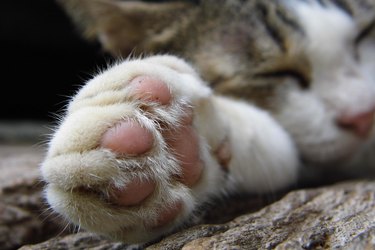Baby Gray Cat With Paw in Its Mouth

Your cat's paws are vulnerable to many dissimilar diseases.
Epitome Credit: Mas042/iStock/GettyImages
It's easy to take a cat's beautiful trivial paws for granted, yet they're vulnerable to a diverseness of atmospheric condition. Ranging from elementary infections to allowed-related disorders, potential cat hand diseases include pillow foot, pemphigus, and eosinophilic granuloma.
What is eosinophilic granuloma?
An eosinophil is a blazon of white blood cell. When a cat has a parasitic infection, her eosinophils are one of her body'southward defense force mechanisms to battle the infection. Occasionally, her body mistakes benign material, such as dust, for more than serious things, such as fleas. When that happens, she'll experience an overreaction to the innocent trigger that leads to damage of her collagen.
Known every bit eosinophilic granuloma circuitous, the reaction can present effectually the cat's mouth or throat, chin or abdomen, hind legs, or footpads. When the cat's footpad is affected, she'll develop lumps on the bottom of her hand that often become ulcerated every bit she walks on them. The status is often cocky-limiting, however, if information technology doesn't clear up, medication such equally cortisone may exist prescribed and the vet may recommend other options such as vigorous flea control, testing for nutrient allergies, and other medications.
Plasma-jail cell pododermatitis, a cat paw infection
Pododermatitis is a mouthful, then you can break it downwardly to its roots and call it cat paw infection or pes inflammation, AKA pillow pes. Pillow human foot occurs when a true cat's lymphocytes produce antibodies in response to inflammation or infection. Symptoms of the condition include a soft, puffy appearance of the paw pad that tin take a purple hue or get ulcerated. Ordinarily more than one foot is affected.
The antibiotic doxycycline is often used to treat plasma-cell pododermatitis. Steroids such as prednisone may exist used if doxycycline is ineffective. At present, this poorly understood status is managed but not cured, ordinarily putting a true cat into remission. Occasionally surgical removal of large masses on the manus pads is required.
Growth on true cat paw or carcinoma
Some other mouthful, digital squamous cell carcinoma is a skin cancer that can develop on a cat's toes and feet and presents as a growth on a cat hand. As a carcinoma, this type of cancer is cancerous and ofttimes returns afterwards removal, however, information technology'due south slow moving, and usually found before it's had an opportunity to spread. Symptoms of this rare foot cancer include:
- Sores and/or bleeding ulcers on the toes.
- Limping or reluctance to move.
- Nodule or papule on the toe.
- Tumors or sores elsewhere on the trunk.
Treating squamous cell carcinoma depends on how many tumors the cat has and where they're located. A single tumor on one toe is usually surgically removed, often through toe amputation. Generally, a cat can expect a full recovery from such surgery, with his move limited while he recuperates. If there are multiple tumors present, hurting medication will provide your cat relief. A veterinary oncologist may be necessary to decide if there are other potential treatments.
Pemphigus foliaceus, erythematosus and vulgaris
When an autoimmune disorder results in pare crusting and ulceration, the condition is referred to every bit pemphigus. The cat'southward body is essentially reacting to itself, producing antibodies that attack the salubrious tissue and cells. Non limited to the paws, pemphigus can affect a true cat'south gums. In that location are three types: foliaceus, erythematosus, and vulgaris.
The symptoms of pemphigus include:
- Footpad overgrowth and cracking.
- Fluid-filled cysts in the skin.
- Lameness.
- Swollen lymph nodes and generalized swelling.
- Depression.
- Fever.
- Itchy, crimson skin.
- Scales, crusts, and pustules.
- Secondary bacterial infections.
In severe cases, a true cat will need supportive care, provided at the veterinarian'south part. Steroids may be used temporarily to provide relief until the condition goes into remission. Monthly or quarterly vet visits during remission help the vet monitor the cat's progress.
True cat paw pad fungus
A cat's hand is vulnerable to infection, either from fungus or bacteria. When a true cat's hook develops a bacterial infection, it'southward often a effect of an underlying status, such equally allergies or autoimmune disorders. The vet will determine if there'due south a root cause to be treated, as well equally prescribe antibiotics. Loose or fractured nails will be removed and, occasionally, a foot scrub or soak helps. In the rare example of cat mitt pad fungus, or a fungal infection, an anti-fungal is prescribed, ofttimes in conjunction with foot soaks and frequent nail trimming to remove infected growth.
A true cat's foot or paw pad may go infected, maybe from stepping on something that acquired a cut or equally an injury when she mixed information technology up with some other cat. Symptoms of a paw infection include:
- Limping.
- Hair loss.
- Scabbing.
- Puncture wound.
- Claret or pus at the wound site.
- Fever.
- Lethargy.
- Loss of appetite.
The vet may use a general anesthesia to relax the cat while her wound is cleaned. Antibiotics such as penicillin typically are prescribed and pain medication also may be necessary.
Always check with your veterinary before changing your pet's nutrition, medication, or physical activeness routines. This information is non a substitute for a vet'due south opinion.
Source: https://www.cuteness.com/article/cat-paw-diseases
0 Response to "Baby Gray Cat With Paw in Its Mouth"
Postar um comentário